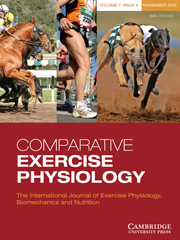Crossref Citations
This article has been cited by the following publications. This list is generated based on data provided by
Crossref.
König von Borstel, Uta
Pasing, Stephanie
Gauly, Matthias
and
Christmann, Ludwig
2013.
Status quo of the personality trait evaluation in horse breeding: Judges' assessment of the situation and strategies for improvement.
Journal of Veterinary Behavior,
Vol. 8,
Issue. 5,
p.
326.
Robartes, Helen
Fairhurst, Harriet
and
Pfau, Thilo
2013.
Head and pelvic movement symmetry in horses during circular motion and in rising trot.
The Veterinary Journal,
Vol. 198,
Issue. ,
p.
e52.
Lucidi, Pia
Bacco, Giuliano
Sticco, Marilena
Mazzoleni, Giancarlo
Benvenuti, Mariateresa
Bernabò, Nicola
and
Trentini, Roberto
2013.
Assessment of motor laterality in foals and young horses (Equus caballus) through an analysis of derailment at trot.
Physiology & Behavior,
Vol. 109,
Issue. ,
p.
8.
Hawson, Lesley A.
Salvin, Hannah E.
McLean, Andrew N.
and
McGreevy, Paul D.
2014.
Riders' application of rein tension for walk-to-halt transitions on a model horse.
Journal of Veterinary Behavior,
Vol. 9,
Issue. 4,
p.
164.
Christensen, J.W.
Beekmans, M.
van Dalum, M.
and
VanDierendonck, M.
2014.
Effects of hyperflexion on acute stress responses in ridden dressage horses.
Physiology & Behavior,
Vol. 128,
Issue. ,
p.
39.
König von Borstel, Uta
Glißman, Chantal
and
Hausberger, Martine
2014.
Alternatives to Conventional Evaluation of Rideability in Horse Performance Tests: Suitability of Rein Tension and Behavioural Parameters.
PLoS ONE,
Vol. 9,
Issue. 1,
p.
e87285.
Egenvall, Agneta
Roepstorff, Lars
Eisersiö, Marie
Rhodin, Marie
and
van Weeren, René
2015.
Stride-related rein tension patterns in walk and trot in the ridden horse.
Acta Veterinaria Scandinavica,
Vol. 57,
Issue. 1,
Pierard, Marc
Hall, Carol
König von Borstel, Uta
Averis, Alison
Hawson, Lesley
McLean, Andrew
Nevison, Charlotte
Visser, Kathalijne
and
McGreevy, Paul
2015.
Evolving protocols for research in equitation science.
Journal of Veterinary Behavior,
Vol. 10,
Issue. 3,
p.
255.
Egenvall, A.
Eisersiö, M.
Rhodin, M.
van Weeren, R.
and
Roepstorff, L.
2015.
Rein tension during canter.
Comparative Exercise Physiology,
Vol. 11,
Issue. 2,
p.
107.
Hyun, Seung-Hyun
and
Ryew, Che-Cheong
2015.
Analysis of the Coordination of the Trunk Tilting Angle and Bilateral Lower Limbs According to the Stirrups Length during Trot in Equestrian: Asymmetric Index Development of Overall Movement Index Algorithm.
Korean Journal of Sport Biomechanics,
Vol. 25,
Issue. 1,
p.
131.
Eisersiö, M.
Roepstorff, L.
Rhodin, M.
and
Egenvall, A.
2015.
A snapshot of the training schedule for 8 professional riders riding dressage.
Comparative Exercise Physiology,
Vol. 11,
Issue. 1,
p.
35.
Eng, Jacqueline T.
2016.
A bioarchaeological study of osteoarthritis among populations of northern China and Mongolia during the Bronze Age to Iron Age transition to nomadic pastoralism.
Quaternary International,
Vol. 405,
Issue. ,
p.
172.
Egenvall, Agneta
Roepstorff, Lars
Rhodin, Marie
Eisersiö, Marie
and
Clayton, Hilary M.
2016.
Maximum and minimum peaks in rein tension within canter strides.
Journal of Veterinary Behavior,
Vol. 13,
Issue. ,
p.
63.
Dyson, Sue
2017.
Equine performance and equitation science: Clinical issues.
Applied Animal Behaviour Science,
Vol. 190,
Issue. ,
p.
5.
Fenner, Kate
Webb, Holly
Starling, Melissa J.
Freire, Rafael
Buckley, Petra
McGreevy, Paul D.
and
Sakakibara, Manabu
2017.
Effects of pre-conditioning on behavior and physiology of horses during a standardised learning task.
PLOS ONE,
Vol. 12,
Issue. 3,
p.
e0174313.
Clayton, H.M.
Smith, B.
and
Egenvall, A.
2017.
Rein tension in novice riders when riding a horse simulator.
Comparative Exercise Physiology,
Vol. 13,
Issue. 4,
p.
237.
Cross, Graham H.
Cheung, Michael K.P.
Honey, Thomas J.
Pau, Michael K.
and
Senior, Kara-Jane
2017.
Application of a Dual Force Sensor System to Characterize the Intrinsic Operation of Horse Bridles and Bits.
Journal of Equine Veterinary Science,
Vol. 48,
Issue. ,
p.
129.
Guire, R.
Mathie, H.
Fisher, M.
and
Fisher, D.
2017.
Riders’ perception of symmetrical pressure on their ischial tuberosities and rein contact tension whilst sitting on a static object.
Comparative Exercise Physiology,
Vol. 13,
Issue. 1,
p.
7.
Veen, I.
Killian, D.
Vlaminck, L.
Vernooij, J. C. M.
and
Back, W.
2018.
The use of a rein tension device to compare different training methods for neck flexion in base‐level trained Warmblood horses at the walk.
Equine Veterinary Journal,
Vol. 50,
Issue. 6,
p.
825.
Egenvall, A.
Byström, A.
Roepstorff, L.
Rhodin, M.
Eisersiö, M.
and
Clayton, H.M.
2018.
Modelling rein tension during riding sessions using the generalised additive modelling technique.
Comparative Exercise Physiology,
Vol. 14,
Issue. 4,
p.
209.


